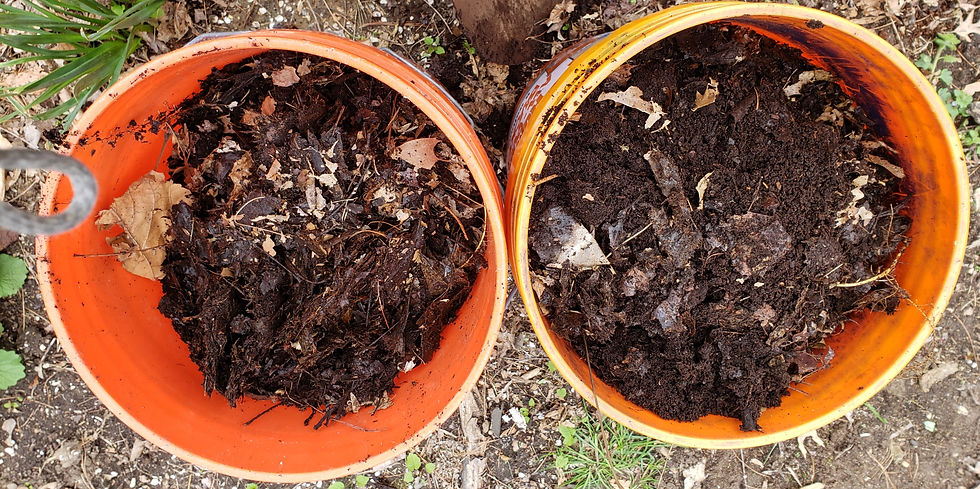Black Gold.......Compost
- Apr 15, 2020
- 4 min read
Updated: Feb 4, 2025
Hello again! It's another week on lockdown and everyone is getting a little antsy to get out of the house. It's been tough with parks closings, but one thing we can do is garden. It is something that gave people the ability to help out with extra produce during WWII and now that people are home, it's something new that people are turning to when perhaps they didn't have the chance or time in the past.
Let's take a look at the Covenhoven House garden and see how it's coming along!

Since our last blog post about the garden, so much has happened but it doesn't look like it. Well, this is the slow part of the season. The seeds and plants are almost all planted - we have onions, asparagus, artichokes, and sweet potatoes left to put in the ground. I stopped by this weekend to see how things were going and if watering was needed. No real sprouting yet except with the peas - they were just barely poking out of the dirt. I almost pulled one up thinking that it was a weed! Oooops.....
The biggest thing we did since the last garden blog was adding compost to our unplanted areas. What is compost? It's decomposed organic material, "black gold", which is a fantastic amendment for garden soil. Especially ours, since it's full of heavy clay. The compost adds the additional nutrients that soil may need and make it less dense. Compost is made from the leaves collected in your yard, grass clippings, fruit and vegetable peelings, etc. Place it all in a pile in your yard, keep adding to it and turning it once in a while until everything is broken down. This doesn't happen overnight, but it will eventually happen. Then that "black gold" can be used in your own garden to help your produce. I won't bore you on how to make your own "formal" compost system - Google has lots of answers for you! I did find a great article about what people in the past used to do for compost. Basically, many just planted in the turned over soil where the organic materials were decomposing. Our first president was also a proponent of compost and had a stercorary (say that three time fast!) at his farm near the horse stables, which makes a lot of sense. It's easy to throw the horse manure in the stercorary (a bin for organic matter such as horse manure and leaves) and then shovel the compost out later for use on the fields.
Where did we get our compost? Under the top level of leaves around the property at Covenhoven House. We have trees that line two sides of the property and there is a layer of leaves from the last number of years sitting under the trees. Under that layer is the compost.

See that stuff under the leaves? That's what we were hunting for. In some places, the decomposing material was about a foot deep. We definitely struck gold - free compost for the taking! Um, yes, those are my ye old Home Depot compost hauling buckets.

Plants
So, why did we plant what we planted? Well, all of the items were grown in Thomas Jefferson's garden at Monticello and are familiar in our current taste palate. We know what asparagus and sweet potatoes taste like. We also know what corn tastes like. But did he have the same varieties as we have today? Yes and no. Yes to plants like artichokes and asparagus, but perhaps no to the corn varieties we buy in the grocery stores. He planted a corn variety called "dent" corn. I am not a gardener and especially not an heirloom variety aficionado. What the heck is "dent" corn? The corn kernels have a small indentation - the "dent" - on the top of them. It is considered a grain corn, is a mix of flour and flint corn, and has a thicker skin on the kernels. The only way to really eat this type of corn is to either dry and grind it into cornmeal for johnny cakes or polenta, or to soak it in lye and remove the skin for hominy.
We are also growing flax! Flax is a fiber from which we can produce linen fabric. This is really exciting for us because we participate in Wool Days, which is a weekend coordinated by the Monmouth County Park System at Holmdel Park where Longstreet Farm and the Holmes Hendrickson House is located. Now we will have the flax for demonstrations and can explain the growing seasons to the Covenhoven House visitors.
TJ was big into peas - he would plant several varieties each year. So we planted peas.
He planted asparagus and globe artichokes. So we added those to the garden, too.
Other items he planted were:
radishes
cucumbers
broccoli
cauliflower
sweet potatoes
"Irish" potatoes, or white potatoes
cabbages
strawberries
pole beans
Spanish onions
gooseberries
currents
I could go on and on and on. When I was reading through Thomas Jefferson's Garden Book, I started at 1767 and ended at 1774. As you can see I didn't have to go far to get a plentiful list for our garden at Covenhoven House. Honestly, his gardens were prolific during those years and this was the same time his law practice increased tremendously and his beloved Shadwell home burned in 1770. He then moved to Monticello to continue his love of gardening. One of the few items that were saved from Shadwell was his garden book.
Whew! This was longer than I thought it would be, but like I said, lots of stuff has been happening with the garden - it just doesn't really show yet.

Oh yeah! I almost forgot! How do we water the garden? It's not a far walk from our "well"......

See you next time!
-- Pati



